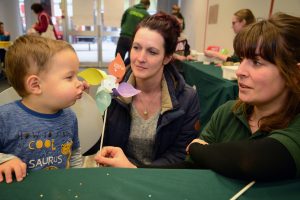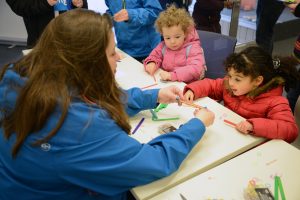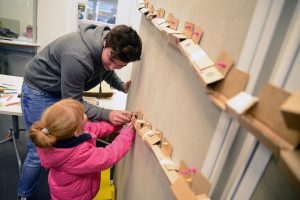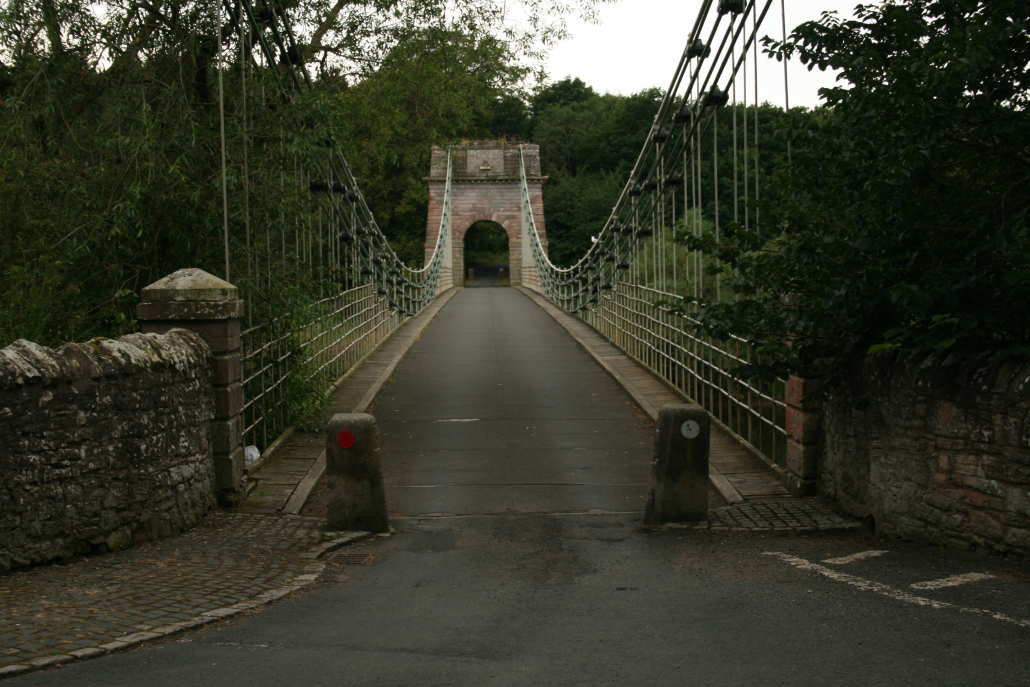
We’ve been running science pop-up shops for a number of years now, in shopping centres across the north-east. These community events enable us work with our “harder to reach” family audiences in ways that we can’t achieve through our school-based workshops.
This post outlines our process for running these events; we hope you might find it useful if you’re setting up your own interventions to support local families. Do contact us if you’d like more information, support, or clarification of anything you see here.
Finding a venue
 NUSTEM works with local communities in areas of higher socio-economic deprivation, because we want to reach families from groups that are currently underrepresented in STEM fields. The locations of these communities are key to finding suitable venues; we can’t expect them to come to us, so we need to go to them. In our case, local shopping centres during half-term holidays have been a good source of the sorts of families with which we want to work.
NUSTEM works with local communities in areas of higher socio-economic deprivation, because we want to reach families from groups that are currently underrepresented in STEM fields. The locations of these communities are key to finding suitable venues; we can’t expect them to come to us, so we need to go to them. In our case, local shopping centres during half-term holidays have been a good source of the sorts of families with which we want to work.
A quick google of shopping centres in the area was a great start: centre websites typically have contact details for the centre manager, then it’s a case of contacting them to find out if they have any vacant lots that could use for events. We’ve built relationships with store managers in three shopping centres in our region, and we run our pop-up shops during each half-term holiday. We’ve found centres to be receptive, supportive, and straightforward to deal with.
Choosing suitable activities
 We pick our activities carefully to make sure that primary-aged children can complete them and that parents and carers can join in too. This is important: we don’t want to be day-care or a break for parents, we want engagements where families talk about and ‘do science’ together. If we can foster this shared discussion about science at the event, parents are more likely to feel confident in continuing discussions at home. Our activities are all designed using cheap, readily-available materials so that families can easily repeat them at home. The activities are also linked to a career. For example, this week we’re showcasing:
We pick our activities carefully to make sure that primary-aged children can complete them and that parents and carers can join in too. This is important: we don’t want to be day-care or a break for parents, we want engagements where families talk about and ‘do science’ together. If we can foster this shared discussion about science at the event, parents are more likely to feel confident in continuing discussions at home. Our activities are all designed using cheap, readily-available materials so that families can easily repeat them at home. The activities are also linked to a career. For example, this week we’re showcasing:
- Construction engineer: soft toy bricks and tools for young children
- Acoustician: noisy lollies
- Mechanical engineer: catapults from cups and spoons
Staffing your event
It’s impossible to know how many people are going to visit your event. With all the advertising in the world, bad weather or a new film at the cinema can impact your numbers. We usually see about 70 people at each event (sometimes more, sometimes a lot less), but we have to plan for rather more ‘just in case.’
Our events are staffed by undergraduates from the University. They attend a one-hour training session where they’re briefed on the activities, ethos of the event, and safety hazards to watch out for. For five activities we plan a minimum of seven staff: this allows each activity to be crewed, with two spare people to further promote the event around the shopping centre, and to support delivery over peak periods and lunchtime.
Marketing
 We’ve learned the hard way that you can’t just put on an event like this and assume families will come flooding through the doors at 10am. If you don’t tell people about your event, nobody will come.
We’ve learned the hard way that you can’t just put on an event like this and assume families will come flooding through the doors at 10am. If you don’t tell people about your event, nobody will come.
That sounds obvious, but solutions are subtle. Our current marketing approach includes:
- A week before, we drop advertising postcards to all the schools local to the area.
- We ask the centres to promote the event on social media and throughout the centre on posters.
- Facebook groups can be a good source of attention, though whether that converts into foot traffic or not can vary.
- During the day, we pace the centre handing out more flyers and (gently!) accosting families.
In the end, the last of those is the only way to ensure that you’re going to have families through the door. It’s worth planning staffing accordingly.
Logistics
Think about how you’re going to present the space you’ll be working in. It’s unlikely that you’ll have tables and chairs provided by the shopping centre (but ask to make sure) so a van and furniture hire might be needed. We can source chairs from our university, but not tables, so we use a local events company: it costs us about £30 to rent tables for two days.
On the day, we give ourselves an hour for setup and takedown, which is ample time with a large enough crew of helpers. Van parking needs planning – ask your centre liaison for their advice, both for unloading and for parking.
Risk assessment
Your venue will likely insist on seeing your risk assessment and public liability insurance documentation. In addition to thinking through each activity and minimising hazards, we use a lot of signage to help ensure that parents know that, ultimately, they are responsible for their children (including their behaviour). Our staff are briefed on the potential hazards for each activity so they can work safely with the public.
You’ll also want to assess the unit you’re working in. This can be tricky as you might not know exactly where you are until the day of the event. Make sure that you walk around the venue before the public enter, carrying out a visual inspection of the whole space. Anything you spot that may be a hazard (particularly trip hazards, in older shops) should be removed, covered or signposted. Talk your risk assessment through with your staff before the public come in. Ultimately, if you are not happy with the space, you need to speak to the manager before you let the public in.
As well as checking the space before you open the doors, check it before you leave at the end of the day. You probably want to return to the same venue, so as a matter of courtesy hand it over in at least as good a state as you found it… and don’t leave anything behind!
And finally…
We’re really proud of the pop-up shops we’ve run over the past three years (23 events and counting!). We’ve reached new audiences and engaged families in science that we definitely wouldn’t have seen otherwise. Sometimes our numbers are low, but that comes with the nature of the audience we want to engage, and it doesn’t put us off. Each new interaction is a chance for us to support a young person and their family in a life-long positive relationship with STEM subjects.
Organising a pop-up shop is always going to be significant work, but over time we’ve managed to streamline the process – partly by keeping the events simple. We’re not trying to be an all-singing, all-dancing glossy representation of cutting-edge research, we’re trying to present STEM explorations as being a normal part of family life. Cardboard and masking tape, casual and friendly staff, a supportive and relaxed atmosphere, people leaving with smiles and a determination to continue activities at home – these are things which matter to our shops.
Further information
This guide from Imperial College, London is useful: it’s a handbook for science pop-up shops which covers a range of different approaches, from interventions which look much like ours through to much more highly-designed, ‘high concept’ spaces. We don’t believe the latter suit our objectives, but it’s worth thinking through your own aims, the circumstances of your audiences, and the capacity you can muster.
If you’d like more information from us, please get in touch.



 NUSTEM works with local communities in areas of higher socio-economic deprivation, because we want to reach families from groups that are currently underrepresented in STEM fields. The locations of these communities are key to finding suitable venues; we can’t expect them to come to us, so we need to go to them. In our case, local shopping centres during half-term holidays have been a good source of the sorts of families with which we want to work.
NUSTEM works with local communities in areas of higher socio-economic deprivation, because we want to reach families from groups that are currently underrepresented in STEM fields. The locations of these communities are key to finding suitable venues; we can’t expect them to come to us, so we need to go to them. In our case, local shopping centres during half-term holidays have been a good source of the sorts of families with which we want to work. We pick our activities carefully to make sure that primary-aged children can complete them and that parents and carers can join in too. This is important: we don’t want to be day-care or a break for parents, we want engagements where families talk about and ‘do science’ together. If we can foster this shared discussion about science at the event, parents are more likely to feel confident in continuing discussions at home. Our activities are all designed using cheap, readily-available materials so that families can easily repeat them at home. The activities are also linked to a career. For example, this week we’re showcasing:
We pick our activities carefully to make sure that primary-aged children can complete them and that parents and carers can join in too. This is important: we don’t want to be day-care or a break for parents, we want engagements where families talk about and ‘do science’ together. If we can foster this shared discussion about science at the event, parents are more likely to feel confident in continuing discussions at home. Our activities are all designed using cheap, readily-available materials so that families can easily repeat them at home. The activities are also linked to a career. For example, this week we’re showcasing: We’ve learned the hard way that you can’t just put on an event like this and assume families will come flooding through the doors at 10am. If you don’t tell people about your event, nobody will come.
We’ve learned the hard way that you can’t just put on an event like this and assume families will come flooding through the doors at 10am. If you don’t tell people about your event, nobody will come.